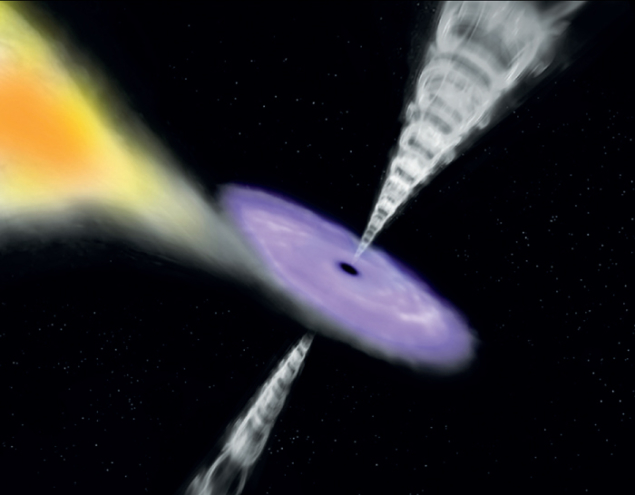
Image credit: ESA/ATG medialab.
One of the open questions of astrophysics is the composition of the powerful jets launched by black holes. Are the jets purely leptonic or do they also contain protons and nuclei? The latter are implied by the recent detection of X-ray emission from iron and nickel atoms in the relativistic jets of a stellar-mass black-hole candidate. Strong γ-ray and neutrino emission is expected in such baryonic jets.
Stellar-mass black holes manifest their presence by accreting material from a companion star. Matter flows from the star towards the black hole, forming a disc of plasma around it with a temperature so high that it emits X rays. The circling of the ionized gas at almost the speed of light is thought to generate a twisted magnetic field perpendicular to the disc, which funnels some of the incoming matter away in the form of two powerful jets of particles. The ejected mass and energy prevents the black hole from growing too quickly.
Observations at radio and other wavelengths have already shown that black-hole jets contain highly relativistic electrons (CERN Courier July/August 2006 p10). However, until now it was not clear whether the negative charge of the electrons is complemented by their anti-particles – positrons – or by heavier, positively charged particles in the jets, such as protons or atomic nuclei. In a new study, a team of astronomers led by María Díaz Trigo of the European Southern Observatory in Munich has used ESA’s XMM-Newton satellite to study a binary system called 4U 1630-47. This system hosts a black-hole candidate and is known to show outbursts of X rays across periods of months and years.
The researchers observed the source twice in September 2012, using both XMM-Newton and the Australia Telescope Compact Array to study simultaneously its X-ray and radio state. Following a first observation without detectable radio emission from the jets, the team was lucky enough to catch the source soon after jet reactivation. In this second observation, the astronomers found X-ray emission lines from two highly ionized heavy elements – iron and nickel. For iron, there is even a second line displaced in energy, suggesting that it comes from the counter-jet moving away from the point of observation. According to Díaz Trigo, the discovery came as a surprise – and a good one, since it shows beyond doubt that the composition of black-hole jets is much richer than only electrons. With iron emission from both jets moving in opposite directions, the team was able to determine the jet’s orientation and its speed at about two-thirds of the speed of light.
This is the first time that heavy nuclei have been detected in the jets of a typical stellar-mass black hole. There is only one other X-ray binary, SS 433, which shows similar signatures from atomic nuclei in its jets, but this source is peculiar, having an unusually high accretion rate. The new observations of 4U 1630-47 should help astronomers to learn more about the physical mechanism that launches jets from a black hole’s accretion disc. A model where the jet is powered by the spin of the black hole rather than by the magnetic field induced by the accretion disc is disfavoured as it would produce leptonic jets only.
The authors of the paper published in Nature also point out that the presence of mildly relativistic baryons in the jets suggests that γ rays could be produced by interaction with high-energy photons or with protons from the stellar wind of the companion star. This could give rise to a signal that would be detectable by the Fermi Space Telescope and the future Cherenkov Telescope Array. The hadronic interactions should also generate an intense flux of neutrinos. Therefore, high-luminosity outbursts from black-hole X-ray binaries could provide the best opportunities for neutrino detection.








